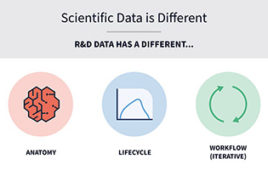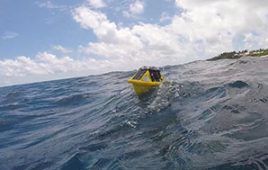 NASA has released a new video in which a compilation of images taken by the Mars Exploration Rover Opportunity’s hazard-avoidance cameras between January 2004 and April 2015 reveals an awe-inspiring rover’s-eye-view of the 26.2-mile marathon from its landing location, as a corresponding map of the rover’s path appears alongside. Audio is derived from vibration measurements from the rover’s accelerometer, with louder sounds corresponding to rougher terrain and softer sounds corresponding to smoother, sandy terrain.
NASA has released a new video in which a compilation of images taken by the Mars Exploration Rover Opportunity’s hazard-avoidance cameras between January 2004 and April 2015 reveals an awe-inspiring rover’s-eye-view of the 26.2-mile marathon from its landing location, as a corresponding map of the rover’s path appears alongside. Audio is derived from vibration measurements from the rover’s accelerometer, with louder sounds corresponding to rougher terrain and softer sounds corresponding to smoother, sandy terrain.
Opportunity completed its first Red Planet marathon on March 24 — 26.219 miles (42.195 kilometers) — with a finish time of roughly 11 years and two months.
“This is the first time any human enterprise has exceeded the distance of a marathon on the surface of another world,” said John Callas, Opportunity project manager at NASA’s Jet Propulsion Laboratory (JPL) in Pasadena, CA. “A first time happens only once.”
The long-lived rover surpassed the marathon mark during a drive of 153 feet (46.5 meters). Last year, Opportunity became the long-distance champion of all off-Earth vehicles when it topped the previous record set by the former Soviet Union’s Lunokhod 2 moon rover.
- Watch video: Rover’s-Eye View of Marathon on Mars
NASA’s Mars Exploration Rover Project landed twin rovers Spirit and Opportunity on Mars in 2004 to begin missions planned to last three months. Both rovers far exceeded those plans. Spirit worked for six years, and Opportunity is still active.
NASA reports that operators of the Rover Opportunity plan to drive it into a valley this month where it will be active through the long-lived rover’s seventh Martian winter, examining outcrops that contain clay minerals. Engineers and scientists have chosen Marathon Valley as the location for the solar-powered rover to spend several months, starting in August, to take advantage of a sun-facing slope loaded with potential science targets.
Opportunity resumed driving on June 27 after about three weeks of reduced activity around Mars solar conjuntion, when the sun’s position between Earth and Mars disrupts communication.
• CONFERENCE AGENDA ANNOUNCED: The highly-anticipated educational tracks for the 2015 R&D 100 Awards & Technology Conference feature 28 sessions, plus keynote speakers Dean Kamen and Oak Ridge National Laboratory Director Thom Mason. Learn more.
The rover is working about half a football field’s length away from entering the western end of “Marathon Valley,” a notch in the raised rim of Endeavour Crater, which is about 14 miles (22 kilometers) in diameter.
Opportunity’s original three-month prime mission in 2004 yielded evidence of environments with liquid water soaking the ground and flowing on planet’s surface. As the rover continued to operate far beyond expectations for its lifespan, scientists chose the rim of Endeavour Crater as a long-term destination. Since 2011, examinations of Endeavour’s rim have provided information about ancient wet conditions less acidic, and more favorable for microbial life, than the environment that left clues found earlier in the mission.
Findings about ancient wet environments on Mars have come from both rovers. The project is one element of NASA’s ongoing and future Mars missions preparing for a human mission to the planet in the 2030s.
JPL manages the Mars rover projects for NASA’s Science Mission Directorate in Washington. The Mars Exploration Rover Project, NASA’s newer Curiosity Mars rover, and three active NASA Mars orbiters are part of NASA’s Mars Exploration Program, which seeks to characterize and understand Mars as a dynamic system, including its present and past environment, climate cycles, geology and biological potential.
In parallel, NASA is developing the human spaceflight capabilities needed for its journey to Mars.
For more information about Opportunity, visit: http://www.nasa.gov/rovers, http://marsrovers.jpl.nasa.gov




